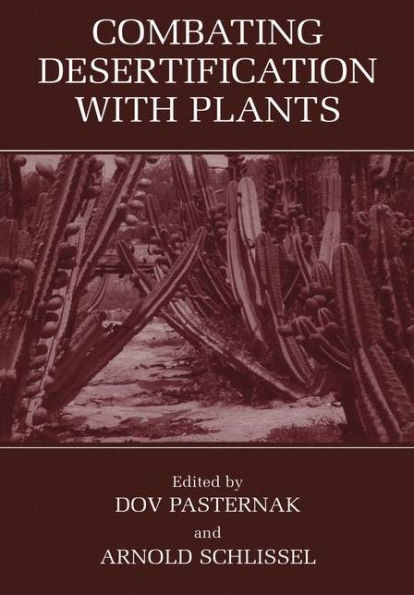5
1

Combating Desertification with Plants
462
by D. Pasternak (Editor), Arnold Schlissel (Editor)
D. Pasternak

Combating Desertification with Plants
462
by D. Pasternak (Editor), Arnold Schlissel (Editor)
D. Pasternak
Hardcover(2001)
$169.99
-
PICK UP IN STORECheck Availability at Nearby Stores
Available within 2 business hours
Related collections and offers
169.99
In Stock
Overview
The conference "Combating Desertification with Plants" was held in Beer Sheva, Israel, from November 2-5, 1999, and was attended by 70 participants from 30 countries and/or international organisations. Desertification - the degradation of soils in drylands - is a phenomenon occurring in scores of countries around the globe. The number of people (in semiarid regions) affected by the steady decline in the productivity of their lands is in the hundred millions. The measures required to halt and reverse the process of desertification fall into many categories - policy, institutional, sociological-anthropological, and technical. Although technical "solutions" are not currently in vogue, the conference organizers felt that perhaps the pendulum had swung too far in the direction of "participatory approaches." Hence IPALAC - The International Program for Arid Land Crops - whose function is to serve as a catalyst for optimizing the contribution of plant germplasm to sustainable development in desertification-prone regions - felt the time was opportune for providing a platform for projects where the "plant-driven" approach to development finds expression. Some 45 papers were delivered at the conference, falling into the categories of this volume: Overview, Potential Germplasm for Arid Lands, Introduction, Domestication and Dissemination of Arid Land Plants, Land Rehabilitation, and Mechanisms of Plant Transfer. The conference was funded by UNESCO (Division of Ecological Sciences), the Ministry of Foreign Affairs of Finland, and MASHAV, Israel's Center for International Development Cooperation.

Product Details
| ISBN-13: | 9780306466328 |
|---|---|
| Publisher: | Springer US |
| Publication date: | 09/30/2001 |
| Edition description: | 2001 |
| Pages: | 462 |
| Product dimensions: | 7.01(w) x 10.00(h) x 0.04(d) |
Table of Contents
1. Some Observations Relating to the Global Agricultural Situation.- 2. Combating Poverty with Plants.- I: Potential Germplasm for Arid Lands.- 3. The Role of Horticulture Plants in Combating Desertification.- 4. Terfezias, a Family of Mycorrhizal Edible Mushrooms for Arid Zones.- 5. The Role and Potential of Traditional Tuber Crops in Malawi.- 6. Honeybees and Nectariferous Plants in the Desert are an Important Factor to Sustain Modern Agriculture.- 7. Importance of Non-Wood Forest Products as Source of Rural Women’s Income in Western Burkina Faso.- 8. Ethnobotany and Importance of Three Local Species in Northern Cameroon.- 9. Potentials of Non-Wood Forest Products of the Semiarid Regions of Uganda.- 10. Biodiversity Prospecting in Drylands of Latin America.- 11. Provenance Trial for Indigenous Tree Species.- II: Introduction, Domestication and Dissemination of Arid Land Plants.- 12. Introduction and Selection of Drought and Salt Tolerant Plants for Afforestation and Landscaping in Arid Lands.- 13. The Screening of Multipurpose Tree Species for Agroforestry Practices in the Semiarid Ecozone of Ghana.- 14. Results of 50-Year Studies on Afforestation as Related to the Problem of Desertification Control in Ciscaspian Lowland in Russia.- 15. Citrullus colocynthis, an Israeli Desert Plant, as a Potential Source of Edible Oil.- 16. Euphorbia tirucalli for High Biomass Production.- 17. Boraginaceae as Potential Sources of Gamma-Linolenic Acid.- 18. Root Involvement in Plant Development and Productivity under Semiarid Conditions.- 19. Acacia mearnsii for Income Generation and Environmental Protection in Kenya.- 20. Potential of Australian Acacias for Human Food.- 21. The Effect of Shade on Initial Growth, Development and Occurrences of Leaf Diseases on Wild Indigenous FruitTrees.- 22. Afforestation of Semiarid Areas of Tanzania: Focusing on the Root Compartment.- 23. Introduction of Cacti as Vegetable Crops for Israel.- 24. Upscaling the Experimental Planting of Argania spinosa at Kibbutz Ketura, Israel.- 25. Mungbean (Vigna radiata L.), a Choice Crop for Improvement of Human and Soil Health in Southern Africa.- 26. Many Problems and Some Solutions to the Commercialisation of NTFPs in Botswana.- 27. Fighting Desertification by Production and Use of Jatropha Oil.- III: Land Rehabilitation.- 28. Combating Desertification with Seabuckthorn.- 29. Reversing Desertification with Tamarix in China.- 30. Bioreclamation of Saline Soils of the Western Coast of Senegal.- 31. Utilizing the Underground Forest: Farmer Managed Natural Regeneration of Trees.- 32. Sand Dune Stabilization with Plants in China.- 33. Development of a Technology for Sand Dune Stabilization in Northern Nigeria.- 34. Sand Dune Stabilization Practices Implemented in Turkey.- 35. Desertification in the West Bank and Gaza Strip.- 36. Reversing Desertification through Large, Herding Ungulates.- IV: Mechanisms of Plant Transfer.- 37. Passive Transfer.- 38. Response to Agroforestry Intervention.- 39. FAO, Plants and Sustainable Development in Drylands.- 40. Combating Desertification with Trees.- 41. Promoting Indigenous Tree Species Plantation in the Sahel, with Special Reference to Burkina Faso.- 42. Incorporating Tree and Shrub Species into Small Scale Farming Systems in the Dry Region of Indonesia.- 43. Obstacles to the Adoption of Cover Crops.From the B&N Reads Blog
Page 1 of
